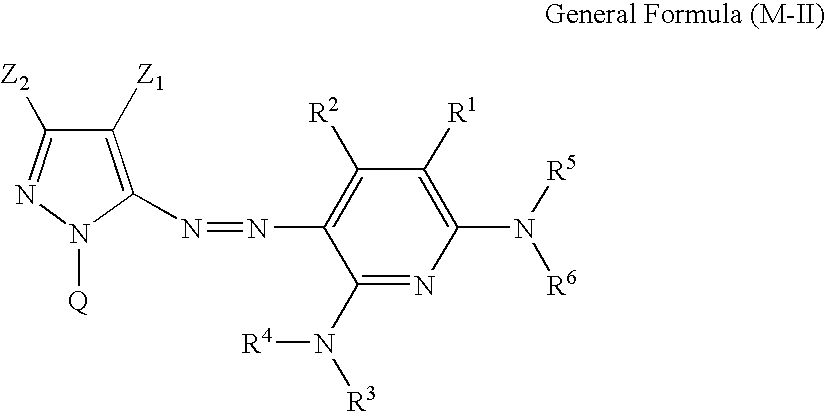Inkjet recording method
- Summary
- Abstract
- Description
- Claims
- Application Information
AI Technical Summary
Benefits of technology
Problems solved by technology
Method used
Image
Examples
example 1
(Preparation of Aqueous Ink)
[0515]Deionized water was added to the following ingredients to make 1 liter, and stirred for 1 hour under heat at 30 to 40° C. Next, its pH was made 9 with 10 mol / liter of KOH added thereto, and this was filtered under reduced pressure through a 0.25 μm-microfilter to prepare light magenta ink.
[0516]
Magenta dye (T-1) of the following structural formula 7.5 g / literDiethylene glycol 50 g / literUrea 10 g / literGlycerin 200 g / literTriethylene glycol monobutyl ether 120 g / liter2-Pyrrolidone 20 g / literSURFINOL 465 (surfactant by Air Products Japan, Inc.)10.5 g / literTriethanolamine 6.9 g / literBenzotriazole0.08 g / literPROXEL XL-2 (microbicide by ICI Japan) 3.5 g / liter
[0517]The dye and the additives were varied, and magenta ink, light cyan ink, cyan ink, yellow ink and black ink were prepared to produce an ink set 101 as in Table 1.
[0518]
TABLE 1Composition of Ink Set 101Light MagentaMagentaLight CyanCyanYellowBlackDye (g / liter)T-1 (7.5)T-1 (30.0)T-2 (8.75)T-2 (3...
example 2
[0547]The same ink as that produced in Example 1 was charged into an inkjet printer BJF900 (by Canon Inc.), with which an image was printed on the inkjet recording sheet (A4). This was evaluated in the same manner as in Example 1, and it gave the same result as in Example 1.
example 3
[0548]An ink set 201 was prepared in the same manner as in the ink set 101 in Example 1, except for using oil-soluble dye inks of light magenta, magenta, light cyan, cyan and yellow dyes prepared in the manner mentioned below.
[0549]8 g of a dye (M-24) and 60 g of a surfactant (EMAL 20C by Kao Corporation) were dissolved in 6 g of a high-boiling-point organic solvent (S-1), 10 g of a high-boiling-point organic solvent (S-2), 1.0 g of an additive (A-1) and 50 ml of ethyl acetate at 70° C. With stirring with a magnetic stirrer, 500 ml of deionized water was added to the resulting solution to prepare a coarse, oil-in-water dispersion.
[0550]The structural formulae of the high-boiling-point organic solvents (S-1) and (S-2) and the additive (A-1) are shown below.
[0551]
[0552]Next, the coarse dispersion was fined down by passing it five times through a microfluidizer (by Microfluidex Inc.) under a pressure of 60 MPa. Further, the resulting emulsion was evaporated for solvent removal by using...
PUM
| Property | Measurement | Unit |
|---|---|---|
| Electric potential / voltage | aaaaa | aaaaa |
| Particle diameter | aaaaa | aaaaa |
| Fraction | aaaaa | aaaaa |
Abstract
Description
Claims
Application Information
 Login to View More
Login to View More - R&D
- Intellectual Property
- Life Sciences
- Materials
- Tech Scout
- Unparalleled Data Quality
- Higher Quality Content
- 60% Fewer Hallucinations
Browse by: Latest US Patents, China's latest patents, Technical Efficacy Thesaurus, Application Domain, Technology Topic, Popular Technical Reports.
© 2025 PatSnap. All rights reserved.Legal|Privacy policy|Modern Slavery Act Transparency Statement|Sitemap|About US| Contact US: help@patsnap.com



